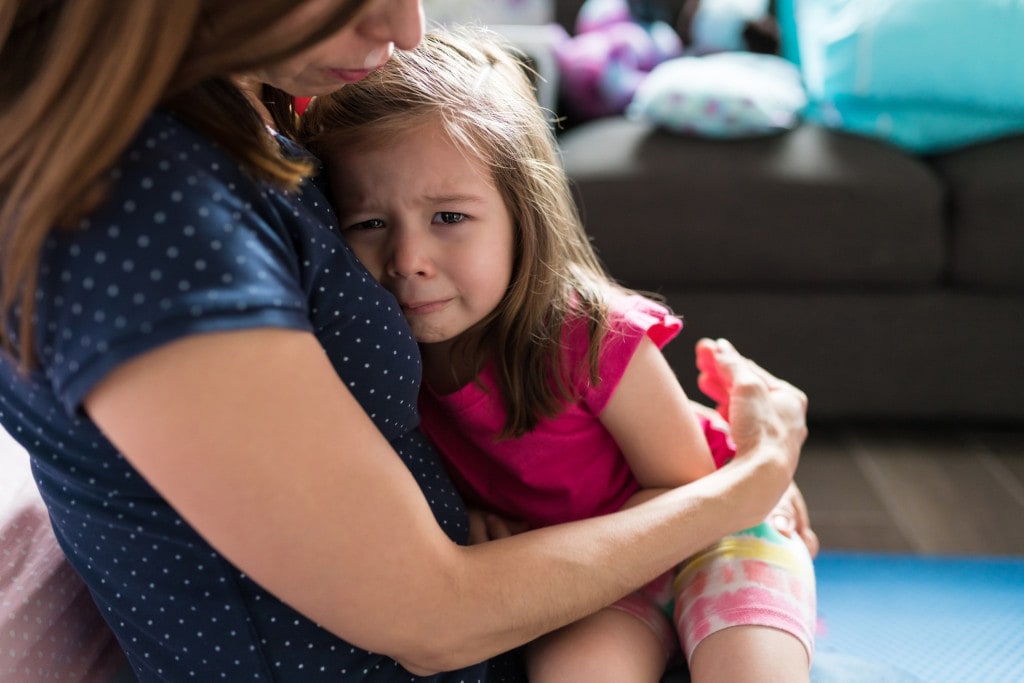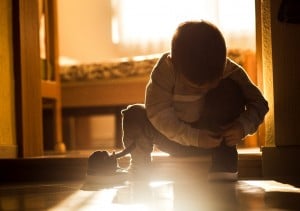I notice the overwhelmed mother’s cheeks turning bright red, her breathing quickening, her eyes widening and darting around the store, wondering if anybody else is watching this all unfold. Her son, maybe 2.5 years old, has erupted into a full-blown toddler tantrum in the middle of the store aisle. He is lying face down on the floor, kicking his legs, stomping his fists, and wailing.
Watching this scene makes my heart race and chest tighten, partly because my heart aches for this mom but also because I know this could have been me and likely will be me again soon. The mother’s eyes catch mine, and I gently smile at her. “I totally get it. This happens to me anytime I bring my son, too.” Her shoulders relax a bit, and she smiles in return, thankful not to be completely alone in this moment and stage of motherhood. All it takes is that little encouragement for mom to take a deep breath, compose herself, and return her attention to her son with newfound focus and stamina. She then handles the situation like the mother boss that she is.
Chances are, if you have ever parented a toddler and dared to take them anywhere in public, you have found yourself in a similar situation, probably more than once. Let’s explore how to handle toddler tantrums better by showing empathy for our little ones and what they’re experiencing.
What Causes Toddler Tantrums?
Tantrums come in all shapes and sizes. Your child will demonstrate all sorts of disorganized behavior — screaming, flailing, arching their backs, kicking, holding their breath, vomiting, or hurting themselves or other people. The most common triggers for toddler tantrums are when our little one is hungry, overtired, or overstimulated or when they have an unexpected change in routine.1
Toddler tantrums also occur because our little ones struggle with communication and can’t tell us what they need.3,6 This can make them pretty frustrated . . . cue tantrum! In addition, our toddlers grapple with an increased need for control; they want to feel in charge of their world and do things for themselves but can’t quite manage yet.2,6 A tantrum is a behavior, and this behavior is communicating an underlying need.3 So, get curious and pay attention to the pattern of your child’s meltdowns and what their underlying need might be. Do they want a connection or to feel loved? Are they looking for security or safety? Is it time for them to eat or take a nap?
Toddler Tantrums Are Normal
As frustrating as they are for the caregiver and the child, toddler tantrums are completely normal and developmentally appropriate for children aged 1-3.2,6 Even if you ensure your child is fully rested, eats lunch right before you leave, has a clean diaper, and anything else you can think of and can control has been accounted for, these moments still happen to the best of us. You are not alone!
Toddler tantrums are your child’s way of showing that their feelings are so overwhelming inside their body they can’t stay there any longer but need to burst out in the form of dysregulated behavior. They are healthy and necessary because they are one of the ways your child can express themselves and try to change what is happening around them.3 As parents, we can only control our reaction and response in these moments; we cannot control our child or stop the tantrum before it has been played out. Be encouraged and know you can handle these difficult moments and remain in complete control. Our children depend on it.
How To Respond to Toddler Tantrums With Empathy
Empathy is defined as the psychological identification with or vicarious experiencing of the feelings, thoughts, or attitudes of another.4 I want to invite you to discover how you might respond to toddler tantrums as a steady leader with clear boundaries but also with gentleness and empathy.
Kelly Nadel, a mother and licensed clinical social worker trained by Dr. Rebecca Kennedy (a psychologist known as Dr. Becky), has terrific advice and tools she offers her clients to handle toddler tantrums.5 Her parenting approach, which she describes as connected- or relationship-based, fully aligns with many of today’s parents’ desires and values in their parenting style. I spoke with her about toddler tantrums, and she has so much wisdom and encouragement to share. Here are some ways parents can respond to these situations with empathy:
Shift Your Focus
One thing to understand is that there is so much emotion beneath a toddler tantrum. If we address only the behavior we want to stop, there is a large and crucial part of the experience we are disregarding. Instead of focusing on the behavior, what if we helped them address and deal with the underlying emotion? I propose we shift our focus and approach our children with the mentality that we want to help them, not discipline them or “fix” their behavior.
Remember, toddler emotions are big. Your child acts out of control because they feel out of control. They aren’t giving you a hard time; they are having a hard time. That shifts things a bit, doesn’t it? They don’t want to misbehave or feel bad any more than we want them to.
Just as it is challenging to parent your child while they have a tantrum, it is tough for your child to figure out what is happening within their body. Accepting that your child is struggling to handle something difficult encourages you to be patient so that you can teach and help them through their distress. Adjusting your mindset may help transform your relationship with them and promote healthy development.
Acknowledge and Validate
Once a tantrum has begun and you are past the point of no return, explain what you notice is happening. One of the most important things we can do is acknowledge and validate our child’s feelings. We want to reassure our children that all their feelings, especially big or dark ones, are allowed, and some behaviors must be limited. Help your child, who may not have the words to name or articulate their feelings, to expand their emotional language. Because they are incapable, our children rely on us to use our communication skills to explain their feelings.
Hearing their caregiver say, “I believe you,” is powerful for a child. “I see that you are feeling ___ right now. It is okay to feel ___. I am feeling ___ right now, too.” Let them know you also experience these feelings. This language can make such a tremendous impact.
Go through the experience with them. Sit down. Remain calm. Soften your heart. Be present. Observe. Remain confident. Give them space if they are angry, or move toward them for an embrace if they are sad. Be clear and hold your gentle limits. Show them they are not too much for you. Let them see you in control, the calm next to their chaos. Tell them you are right there with them, and they are safe with you. Again, they must feel heard, seen, validated, and understood.
Build New Coping Skills
Little building happens during the toddler tantrum. It needs to play itself out. Once they release all that emotion, they come back online and get back in their body. You cannot judge the effectiveness of your interventions based on their immediate response.
Later, when things settle down, you can come back together and discuss what might happen next time or how they can effectively redirect frustrated energy. Teach them calming techniques. Perhaps they can squeeze and release their hands, jump into a pile of pillows, push a wall, or hold or throw softballs. You can even get creative and build a calming toolbox or a calming corner in your home.
Role-playing is also a great way to help your child develop new coping skills. You can share a story about a time when you shared those same feelings. Ending with a story of sameness will allow you to move forward, feeling connected. You are showing them empathy and demonstrating you hear them and understand them. This goes a long way to reducing the frequency and intensity of their tantrums.
Your Goal Is Not Perfection
We must protect our children, validate their emotional experiences, show empathy, and set boundaries. Kelly reminds us that our goal for handling these moments should not be perfection. “Don’t be too much bigger than them. It is about connection, relationship building, and stress tolerance. If everyone is doing their job correctly, things should look pretty messy. Parenting toddler tantrums is hard because we are learning something. It is recognizing that my kid is doing exactly what they are supposed to do and deciding, ‘how do I want to show up?'”
Encourage your child to feel and recognize their feelings fully. Down the line, this will help with their identity and confidence in trusting themselves. Kelly encourages us, “The one thing we want to take home is when we see emotions, we want to greet the emotion, meet them with compassion and curiosity, and permit them to fully embrace their emotions, so they don’t close down but open emotion up.” We parent our children how we want them to mature and develop. Kids who are initially dysregulated will hopefully co-regulate with a parent and ultimately grow into self-regulated adults.
Love Them at Their Most Unlovable
By showing our children empathy, we teach our children empathy so they can mature into compassionate adults. We develop kindness in our children by modeling what it looks like to be kind to others. By noticing other people’s feelings and emotions and pointing them out to our children, they become more aware and consider others.
Remind your child they are courageous when they come to you with big feelings. Remember to focus on your connection if you are ever in doubt about what to do and how to handle your child’s behavior. Remain united. Prioritize the relationship with your child, first and foremost. Loving our children in their most unlovable moments is what this is all about.
Disclaimer: While I am a doctor, I am not your child’s doctor. All content presented in this article is for educational purposes only. It does not constitute medical advice and does not establish any kind of doctor/patient relationship. Speak to your child’s healthcare provider about any questions or concerns you may have.




































